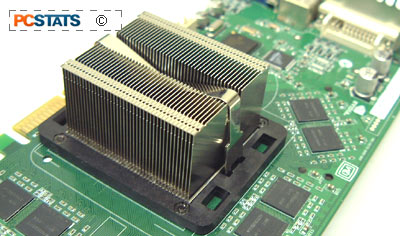Similar to what we saw with FX5900 cards, the fan seems a
little louder than the cooling solution on ATI's Radeon 9800 Pro, but it's still
not loud by any means, and certainly quieter than several recent Nvidia designs.

The Gigabyte GV-N595U's cooling 'hood' and
fan can be removed fairly easily, exposing the large aluminum heatsink covering the
core. Interestingly, this
is clipped onto a frame surrounding the core with a method resembling that of an
old socket 370 heatsink. This too is fairly easy to remove, for those who are
into alternative cooling solutions.
 The
GV-N595U requires an extra power connector, the plug for which is thoughtfully
mounted at the rear of the card. Looking from outside the case, we have the
standard VGA, DVI and S-video outputs.
The
GV-N595U requires an extra power connector, the plug for which is thoughtfully
mounted at the rear of the card. Looking from outside the case, we have the
standard VGA, DVI and S-video outputs.
As a result of
the size of the transparent wind tunnel stuck onto the card, expect to
lose the use of your top two PCI slots when you install
the GV-N595U.
You might be able to squeeze a card into the second
slot from the top, but judging from our test system, it would be jammed right up
against the card, so it's probably better to leave it empty.
The card sticks out about 6cm from the rear of the
AGP slot, so if your motherboard has IDE ports or memory slots in line with the
AGP slot, you may experience some issues. Most modern boards avoid this problem,
but it's something to look into.
As we mentioned before, the GV-N595U is a heavy
card, so it's recommended that you use it in combination with a motherboard that
has some sort of AGP retention mechanism to ensure that it doesn't wobble free
when mounted sideways. Lacking this, make sure to screw the card into the AGP
bracket firmly during installation, otherwise gravity could cause problems. We
shouldn't have to tell you this though, right?
